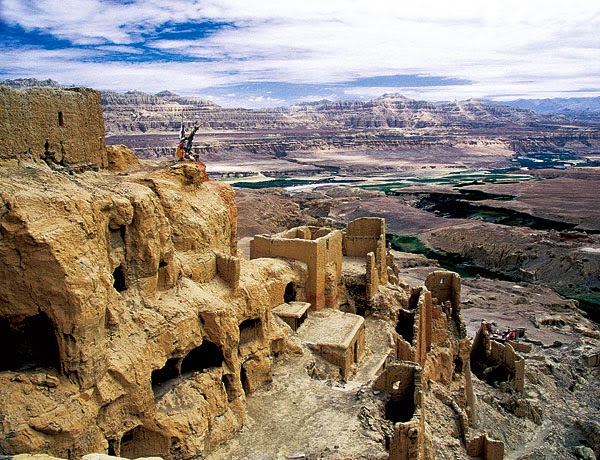The ruins of the Guge
The ruins of the Guge Kingdom are located on a 300-meter-high hill with over 300 caves and destroyed earth buildings in Zhada County of Ngari Prefecture. The great kingdom with 1,000 years history came into existence against nature in a desolate plateau 4,000 meters above sea level nowadays.
The
ruins of the Guge Kingdom are located in Zhabran Village, which is 18
km west of the county town of Zhada, Ngari Prefecture, west
Tibet.Descendants of the Tubo Kingdom founded the Guge Kingdom
in the tenth century AD, who fled from Lhasa after the collapse of
the Tupo Kingdom and developed Guge civilization, a fusion of the
eastern and western culture. The great kingdom with 700 years history
came into existence against nature in a desolate plateau 4,000 meters
above sea level nowadays. The kingdom played an important role in the
second renascence in Tibet and survived for about 700 years before
disappearing mysteriously in the 17th century. What are left here are
the ruins of the capital of the Guge Kingdom.
As
an important part of the Tibetan civilization, the ruins were
designated in 1961 in the county's first group of key cultural relics
under national protection. Large-scale of archeological work began in
1985 when the Tibetan Cultural Committee organized a team to
investigate the place. In the following years of the excavation, a
lot of sculpture works and mural paintings were unearthed. Houses,
cave dwellings, monasteries and stupas were found on the mountain
where the ruins are situated. Their field work showed that there are
a total of 1,416 surviving pieces of architecture, including 879
caves, 445 houses, 58 blockhouses, 28 pagodas, and four tunnels,
which lead in all directions inside the architectural group.
There
are 300-plus caves and crude huts at the foot of the ruins. On the
hillside are temples and monks' dormitories with Buddhist sculptures
and color frescoes inside.
Most
of the sculptures are gold or silver Buddhist statues, among which
the best one is a statue called Guge Silver Eye (Yinyan in Chinese)
In
the middle of the 9th century, the Tubo оf Kingdom collapsed. The
descendants of King Nangdharma established their own independent
kingdoms and Chide Nyimagon became the king of Ngari, who had three
sons. The Guge Kingdom was set up by his second son after he
conquered Tsaparang. The main ruins of the Guge Kingdom are in
Tsaparang where the dilapidated construction and the natural earth
piles are perfectly integrated. More than 400 rooms and 800 caves are
piled up on the slope of the hill, which is 300m high. Being the
capital city of the Guge kingdom, the Tsaparang ruins are the largest
complex in Tibet next to the Potala Palace, which covers an area of
720,000 sq. m. The main buildings of the Guge Kingdom consist of the
red and white temples as well as mandala halls. The murals covering
over a thousand square meters can be seen as its most precious
remains. Among these murals there are paintings of creatures such as
creature with human-headed but snake body, which is very rare in
other places.
The
murals are preserved in good condition, although they are
hundreds of years old. The themes of the murals include every aspects
of the social life of that time. A chapel on the summit of the
mountain houses a mural depicting male and female Buddhas bringing
the Tantric cultivation (civilization) together, while the lower part
displays purgatory with naked, enchanting Dakins flanking each side.
The artistic and aesthetic value of Guge murals is deemed comparable
with that of Mogao Caves (located in Gansu Province, China).
There
are other caves scattered around the ruins, which have preserved some
weapons, helmets and armors used by warriors in the past.
The kingdom played an
important role in the second renascence in Tibet and survived for
about 700 years before disappearing mysteriously in the 17th century.
Large-scale of
archeological work began in 1985. In the following years of the
excavation, a lot of sculpture works and mural paintings were
unearthed. Houses, cave dwellings, monasteries and stupas were found
on the mountain where the ruins are situated.
Most of the sculptures
are gold or silver Buddhist statues, among which the best one is a
statue called Guge Silver Eye.
Guge
abounded with gold and silver. Sutras written with liquid gold or
silver have been excavated in Tholing Monastery and in the villages
of Zhabran, Piyang and Donggar. The sutra was written on a kind of
dark blue paper, with the lines written alternately in liquid gold
and liquid silver.








No comments:
Post a Comment